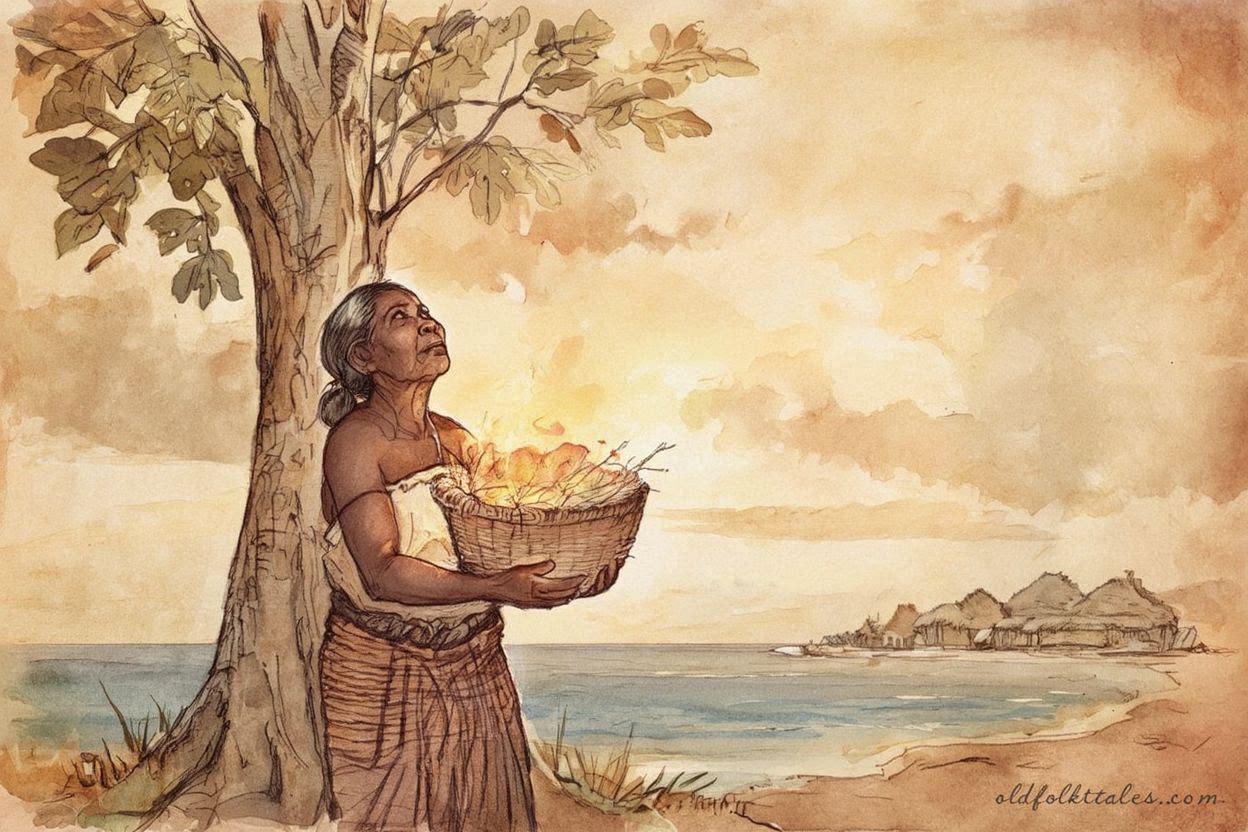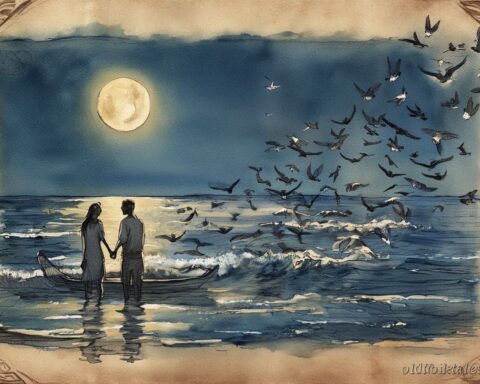Long ago, when the world was still young and the stars shone brighter than they do now, the people of the Marshall Islands lived without fire. They ate their food raw, shivered during storms, and huddled together for warmth when the ocean winds grew cold. At night, they watched the lightning flash in the distance and wondered what made the sky burn so brightly.
The elders said that the fire belonged only to the gods. It was kept far above the clouds, where no human hand could touch it. To try and take it was forbidden, for the fire was said to be alive, a spirit of the heavens that punished those who disrespected it.
Among the islanders lived a young woman named Lejot. She was known for her wisdom and fierce heart. While others accepted life as it was, she could not bear to see her people suffer. “The gods have warmth, yet we have none,” she said one night as families sat cold beneath the stars. “Are we not their children too? Why should light not belong to us as well?”
Many warned her to stay silent. “The gods guard their fire with lightning,” said an elder. “If you try to take it, you will be struck down.”
But Lejot only smiled. “If the fire burns, then I will bring it home.”
One morning, before dawn, she prepared for her journey. She plaited her hair with pandanus leaves for protection, carried a woven basket lined with coconut husk, and prayed to the spirits of her ancestors. Then she set out toward the tallest breadfruit tree in the world, a tree said to reach the very gates of heaven.
The climb was long and perilous. As she rose higher, the winds howled and branches cracked beneath her feet. Birds cried warnings, but Lejot did not stop. Her hands bled, her body trembled, yet her spirit did not falter. At last, after many hours, she reached the cloud-filled summit.
There, beyond the mist, she saw a great fire burning in a shell of stone. Around it stood the gods, their eyes glowing like stars. Lejot hid behind a cloud, watching them feed the flames with golden wood.
“Such beauty,” she whispered. “Such warmth. My people must have it.”
When the gods drifted away to rest, she crept forward. Her heart pounded as she broke a small branch from the divine tree and lit it with the heavenly flame. The fire danced upon the branch, alive and bright. Quickly, she placed it into her basket and began to climb down the tree.
But the gods soon discovered what she had done. The sky roared with anger, and lightning split the clouds. “Who dares to steal the fire of heaven?” thundered their voices.
Lejot clung to the tree as bolts of fire struck around her. Smoke filled the air, and the basket began to shake with heat. She prayed to the ocean below, “Spirits of water, help me carry this flame home!”
At that moment, a strong wind rose from the sea, blowing the storm aside. Lejot descended swiftly, though her skin was scorched and her hands blistered. When she finally reached the ground, her people gathered around in awe.
She opened the basket, and the first flame of the world glowed within. The villagers gasped as she fed it with dry leaves and wood. For the first time, warmth spread through the night air. The people cooked food, sang songs, and danced under the golden light.
The gods watched from above, ready to strike but when they saw the joy and gratitude of the humans, their anger softened. One of them, the goddess of compassion, spoke: “The woman did not steal for greed but for love. Let her people keep the fire, for they now know its sacred power.”
From that day on, the fire belonged to humankind. The people of the Marshall Islands honored Lejot as the bringer of warmth and knowledge. They learned to cook, forge tools, and make light during the darkest storms.
Lejot, however, bore the marks of her sacrifice. Her hands, forever scarred, reminded her of the cost of defying the gods. Yet she smiled whenever she saw the flames flicker in the homes of her people. “Pain fades,” she would say, “but the warmth remains.”
When Lejot’s time came to return to the spirit world, the people built a great fire in her honor. They said that when the flames danced highest, her spirit could be seen climbing once more carrying the light between heaven and earth. And even now, when lightning flashes across the sky, the islanders remember her as the woman who dared to reach the heavens and bring down the fire of life.
Moral Lesson:
True courage is born from love and selflessness. Lejot’s journey teaches that sacrifice for the good of others can change the world. Her fire became more than warmth. it became a symbol of human strength and divine compassion.
Knowledge Check
1. Why did the people of the Marshall Islands need fire?
They lived without warmth or light and could not cook their food.
2. Who was Lejot in the story?
She was a brave woman who climbed to the heavens to bring fire to her people.
3. How did Lejot get the fire from the gods?
She lit a branch from the sacred flame and carried it down in a basket.
4. How did the gods react when they found out?
They were angry, but later showed mercy after seeing her pure intentions.
5. What did Lejot sacrifice to bring fire to her people?
She risked her life and suffered burns from the divine flame.
6. What does the story teach about courage and sacrifice?
That true bravery lies in risking oneself for the good of others.
Source: Adapted from Myths of Fire and Sky from the Marshall Islands by the Pacific Traditions Archive 2012
Cultural Origin: Marshall Islands Micronesia









